ORDER
Falconiformes
FAMILY
Cathartidae
GENUS & SPECIES
KEY FEATURES
• Soars at altitudes up to 18,000′ and can spot an animal carcass from a distance of several miles
• Has the largest wing area of any bird (nearly 6.5 sq. ft., allowing it to glide on rising air currents
• Can devour up to 15 lbs. of flesh at one sitting, but may eat so much it can’t take off again
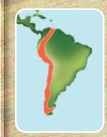
Found high in the Andes mountains of western South America, over the grasslands of Argentina south of the Rio Negro and on the coasts of Peru and Chile
Lifecycle
Hanging like a huge kite on the breeze, the condor performs the role of “undertaker” in its bleak homeland, locating carcasses far below and swooping down to tear into them.
HABITAT

A Sailing on high The condor soars on huge, slotted wings, supported on updrafts above monumentally high peaks.
The Andean condor is native to the Andes mountain chain that extends north to south along the entire length of western South America, but also can be found over the coasts of Peru and Chile and the Patagonian steppe of Argentina.
Wheeling and soaring over high mountains, windswept upland plains and lowland desert areas, the condor looks for signs of other scavengers gathering over carrion. It avoids forests, where locating carcasses and landing is difficult for such a broad-winged bird.
Although the Andean condor doesn’t migrate seasonally it covers huge areas while foraging. It relies on its superb soaring abilities to carry it at high altitudes back to its roosting site each evening. The condor tends to roost and nest on the faces of high cliffs, where few predators can gain access to its eggs and from where it can launch itself easily into the air.
BEHAVIOR
The condor usually roosts on cliff faces because it needs thermals (warm air currents) and cliffside updrafts to carry it aloft. It waits for the morning sun to heat the land and create the thermals and basks until its organs and flight muscles are warmed. When conditions are right for flight, it launches into the buoyant updrafts.
When feeding on hot days from a carcass, the condor absorbs reflected heat from the ground. To stay cool, it radiates excess body heat through loose skin folds on its naked head and deficates on its legs. Back up on high, thick body plumage keeps it warm and it draws its head into its snug, downy neck ruff.
South American Indians believed that eating the condor’s eyes would sharpen their own eyesight.
Quills from Andean condor’s wing feathers were used in mechanisms of harpsichords.
The Andean condor’s
distant ancestors
included the giant
teratorn, Teratornis incredibilis.
This enormous bird had
a wingspan up to 25′.
FOOD & FEEDING
The condor scans the ground for carcasses, but often follows other scavengers, such as smaller vulture species.This benefits lesser vultures — only the condor (with its huge, hooked beak) can rip open the tough skin of some carcasses. Condors and other vultures feed in order of age seniority; each thrusts its head into the carcass for pieces of flesh to gobble down.
The condor feeds mainly on the carrion of mammals such as sheep, cattle and llamas. In coastal areas, it pecks at beached whale carcasses, patrols seal rookeries for casualties and afterbirths and even raids seabird colonies for eggs.
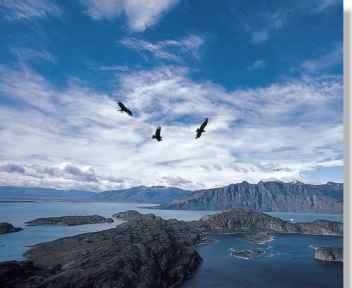

A Land of giants
The condor is the biggest vulture in South America.
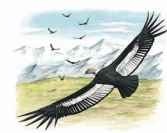
1 Follow the crowd
From high in the sky, the condor scours the horizon. Seeing a flock of vultures circling over a llama carcass, the big bird loses height…
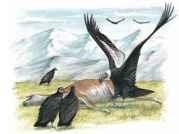
2 Take the lead
…and follows them to a fresh llama carcass lying on the ground.The smaller vultures stand back.
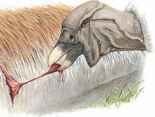
3 Rip
.while the condor uses its stout, hooked bill to make the first cut in the llama’s tough hide. Once it has opened up the belly of the carcass..
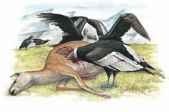
Feed
…the condor eats its fill. Less-senior condors await their turn at the carcass; they’re followed by smaller vulture species.
BREEDING
The condor breeds every other year; and even then only when enough carrion is available to feed the chick. Once paired, however; condors remain together for life.The nest site is usually situated high on a sheer cliff face; in a small cave or recessed ledge.
The female lays a single; white egg on bare rock and both parents share the task of incubation.When the chick hatches, adults feed it partly digested flesh, passing it from bill to bill. As the chick grows, it learns to help itself from food offerings dropped by adults in the nesting area.The juvenile
takes six months to fledge and depends on its parents for many more months before becoming independent.
Meet on the ledge Condors aren’t social, but pairs may use the same cliff ledge for nesting.

CONSERVATION
The Andean condor lives long and breeds slowly; any human interference rapidly upsets this pattern.The condor is hunted for sport and is persecuted by some farmers who believe it kills domestic livestock. It also suffers from pesticides that are carried up through food chains. Numbers have plummeted, but the condor isn’t officially listed as endangered. Recent attempts to rescue the Andean condor and the rare California condor, through captive breeding and habitat research programs, have met with moderate success.
PROFILE
Andean Condor
The Andean condor’s huge wing area allows it to soar on air currents, and its dense plumage keeps it warm at high altitudes.
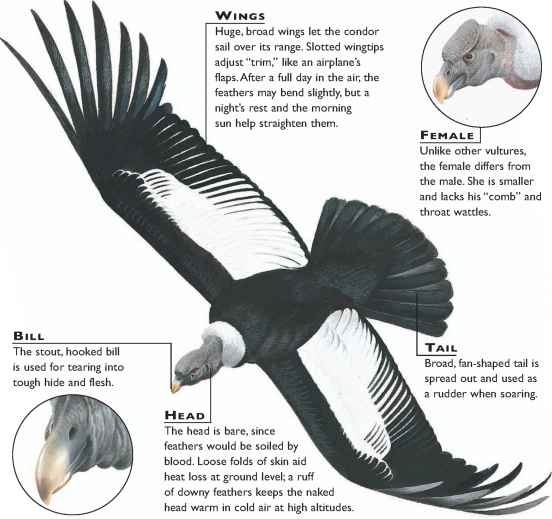
CREATURE COMPARISONS
DNA studies show that the Andean condor isn’t related to Old World (African and Eurasian) vultures, but shows closer affinities to storks. The African marabou stork, for example, has striking similarities to the condor. Like the condor, this stork is a bald-headed carrion eater and locates its prey by soaring at great altitude on huge, deeply slotted wings.

| vital statistics | |
| Weight | Male 24-33 lbs., female 18- 24lbs. |
| Length | 3-4′ |
| WlNGSPAN | Up to 10′ or even more |
| Sexual Maturity | 6-8 years |
| Breeding [ Season | Varies according to location |
| I Number : of Eggs | 1 |
| Incubation Period | 54-59 days |
| 1 Fledging Period | 6 months |
| Breeding Interval | Nests once every two years |
| Typical Diet | Carrion of sheep, cattle, llamas and other mammals |
| Lifespan | Over 50 years |
Related species
• The Andean condor is one of 7 species of New World vulture in the family Cathartidae, including the king vulture (below). The only other condor species is the rare California condor.


